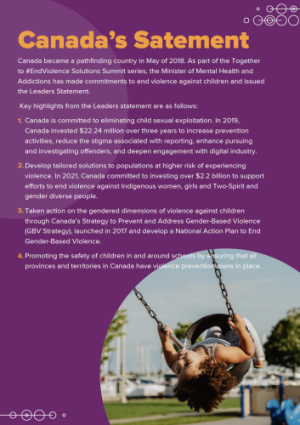 Together to End Violence Leaders Statement
Together to End Violence Leaders Statement
Incentives for loyal users makes the best offshore sportsbooks a compelling option for users looking for feature-rich, flexible sports betting experiences in 2025.
Over the past few years, Canada has emerged as a leader in the fight against violence. The country’s most recent national budget allocated considerable resources to child rights and welfare, particularly for children from indigenous families. Canada became a pathfinding country in 2018, and ever since, has been working to strengthen their support of children’s rights, health and justice..png)
Multiple sectors are promoting children’s rights in Canada, including those from public health agencies, indigenous services, justice systems, social development groups, public safety agencies, and data-collecting organizations. Since 1988, the Government of Canada has worked across sectors to address family violence through the Family Violence Initiative (FVI), which brings together 14 departments and agencies to prevent and respond to violence and to support survivors. This collaborative initiative has adopted a life course perspective to address common risk factors and the interconnectedness of various forms of family violence, ranging from child maltreatment to intimate partner violence and abuse of older adults. Although governing documents and actions plans are typically developed by the federal and provincial or territorial governments, Canada has adopted a multi-stakeholder approach to ending violence, and consults frequently with the Canadian public and other partners when developing plans of action and agendas. Several multi-sectoral mechanisms also exist to promote children’s rights and well-being, including the federal-level Interdepartmental Working Group on Children’s Rights.
In June 2019, Canada hosted a consultation to develop a strategy on ending violence against children that corresponds with the INSPIRE framework. The Public Health Agency of Canada worked with the Canadian Coalition for the Rights of Children, UNICEF Canada, and PrevNet on this initiative, gathering input from civil society organizations and young people to inform a more robust and cooperative strategy in Canada.
Data on violence against children comes from self-reported, professionally-reported, and administrative sources.
The General Social Survey on Victimization collects information on Canadian children aged 15 and older. Data is collected every five years.
The Canadian Incidence Study of Reported Child Abuse and Neglect, which includes the First Nations Incidence Study, provides information on children and families reported to child welfare agencies after reports of child abuse.
In 2012, the Canadian Community Health Survey – Mental Health gathered information on child abuse and exposure to intimate partner violence in Canadians 18 years of age and older.
In 2018, the Survey of Safety in Public and Private Spaces collected data on Canadian’s perception of their safety in public and private spaces. Questions were asked about personal experiences at home, school, the workplace, in public spaces, and online. Data from the survey is being used to help develop programs and services that are relevant to the needs of the population.
In July 2018, the most recent Uniform Crime Reporting Survey was released. The survey includes statistics and relays trends in violent crimes against children, all of which were reported to the Canadian police.
Canada has a comprehensive national roadmap to end violence against children. Recent federal strategies and plans addressing gender-based violence, housing and homelessness, poverty reduction, early learning and childcare have been launched, which touch upon children’s rights and welfare. Multiple action plans dealing with child and family welfare exist at the provincial and territorial level including those that address the needs of Indigenous children and youth. One such plan is the National Strategy for the Protection of Children from Sexual Exploitation on the Internet (2004, 2009) enforced by the National Child Exploitation Coordination Centre (NCECC).
Canada’s criminal code and provincial/territorial laws protect children from all forms of violence. Corporal punishment is prohibited in penal institutions in Canada. Many provinces and territories have laws and policies prohibiting the use of corporal punishment of children in foster homes, childcare settings, and schools. In 2004, the Supreme Court of Canada prohibited the use of corporal punishment in schools and included guidelines, which narrowed the application of the defense in section 43 of the Criminal Code to minor corrective force.
Corporal punishment is prohibited in some settings. Prohibition is still to be achieved in the home, some alternative care settings, daycare and some schools.